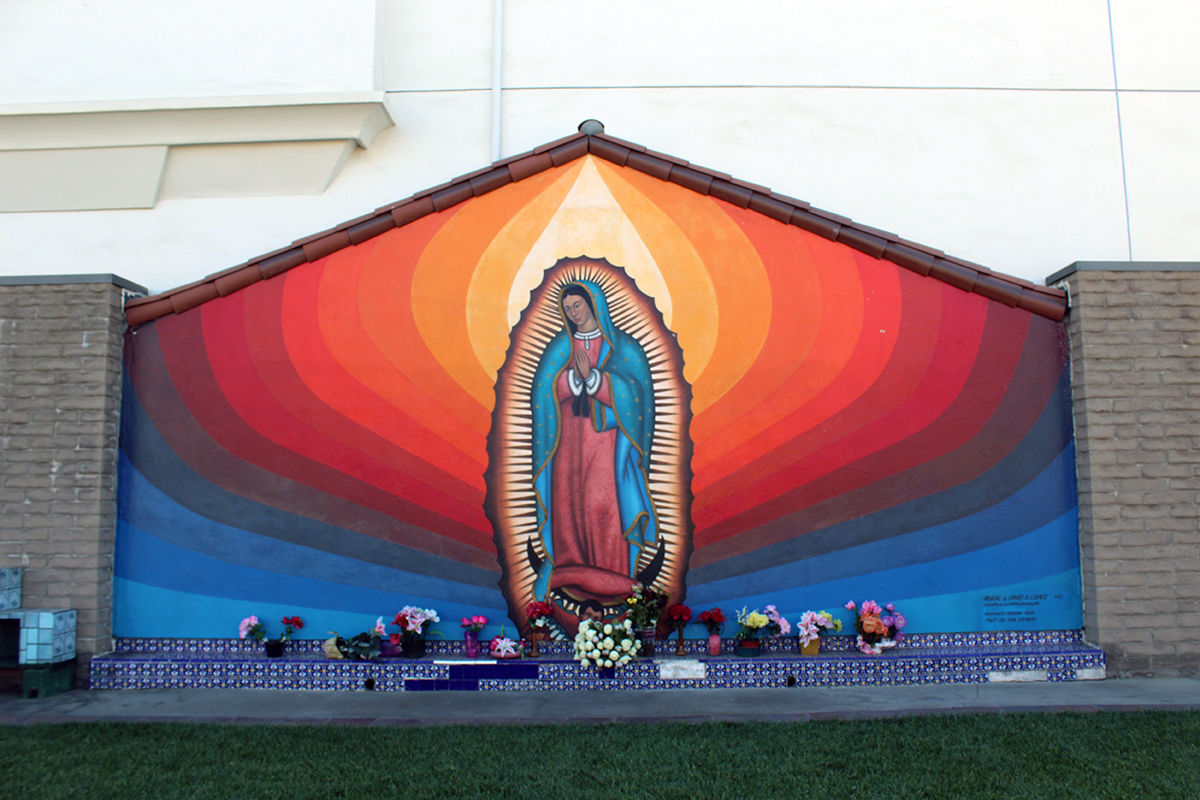Guadalupe Murals: Devotion on the Streets of Boyle Heights and East Los Angeles

Guadalupe mural on Mednik Avenue in East Los Angeles.
Photo by Natalie Amador Solis
In Latinx cultures, Our Lady of Guadalupe is colloquially venerated as the mestiza Virgin Mary, a brown-skinned young woman with long black hair, dressed in a rose-hued gown and blue-green mantle adorned with gold stars. Surrounded by a radiant mandorla, she stands with the palms of her hands together with a contemplative gaze that projects kindness and warmth. Believed to have miraculously appeared in 1531 near present-day Mexico City to an Indigenous man named Juan Diego Cuauhtlatoatzin, Our Lady of Guadalupe is a constantly reclaimed figure in Latinx—and especially Mexican, Mexican American, and Chicanx—communities.
Throughout Los Angeles, and particularly on the eastside, murals of Our Lady of Guadalupe are everywhere: guarding liquor stores, embellishing areas of public worship, constructing neighborhood identities, and commonly appearing as Instagram backdrops. Set in a dynamic urban environment, Guadalupe murals create sacred space, serving as sites to express everyday devotion and protection for local business owners adorning their storefronts.
Growing up in Los Angeles, the sheer number and artistic variations of Guadalupe murals intrigued me to the point that I began photo documenting them and interviewing local community members about their relationship with the murals. Most of my research took place in Boyle Heights, a neighborhood east of the concrete-laden Los Angeles River with a multicultural past, previously home to the Jewish community and currently home to a predominantly Latinx population threatened by gentrification. Neighboring Boyle Heights, East Los Angeles is an epicenter of Chicanx art and activism with the “single largest Chicanx/Mexicanx population in the country.”
While Los Angeles was once honored as the mural capital of the world, the mural ordinance restrictions enacted by the city in 2013 and rampant gentrification have contributed to the decrease in new murals and the destruction of existing, beloved ones. My hope is that online visibility can lead to appreciation and advocacy for muralism, especially the Guadalupe murals that create sacred space, inviting community members to engage with our cultural and spiritual heritage.

-
1 / 18Contemporary interpretation of a Guadalupe mural at La Bodega, The Urban WarehousePhoto by Natalie Amador Solis
-
2 / 18Guadalupe mural by Juan Solis at Mariachi Plaza in Boyle HeightsPhoto by Natalie Amador Solis
-
3 / 18Guadalupe mural created by the Volunteers of East LAPhoto by Natalie Amador Solis
-
4 / 18Guadalupe mural at La Flor de Salivayo restaurant in East Los AngelesPhoto by Natalie Amador Solis
-
5 / 18Guadalupe mural at a parking lot in East Los AngelesPhoto by Natalie Amador Solis
-
6 / 18Guadalupe mural with red rose offerings at a carnicería (meat market) in East Los AngelesPhoto by Natalie Amador Solis
-
7 / 18Guadalupe mural at the Ramona Gardens housing projectPhoto by Natalie Amador Solis
-
8 / 18Guadalupe mural by Juan Solis at Libros Schmibros community bookstore in Boyle HeightsPhoto by Natalie Amador Solis
-
9 / 18Stenciled Guadalupe mural with a floral motif backdrop in Boyle HeightsPhoto by Natalie Amador Solis
-
10 / 18Guadalupe mural with veladora (prayer candle) offerings at an East Los Angeles homePhoto by Natalie Amador Solis
-
11 / 18Guadalupe mural at the Santa Cruz MarketPhoto by Natalie Amador Solis
-
12 / 18Guadalupe mural at Zamora Brothers restaurant in East Los AngelesPhoto by Natalie Amador Solis
-
13 / 18Guadalupe mural at a dead-end street near the U.S. 101 freeway. “We did it for the people,” says muralist Fabian Debora, who created it along with Raul Gonzalez in 2002. “There were lots of deaths and violence at one point, so we painted her to bring life to this dead end.”Photo by Natalie Amador Solis
-
14 / 18“Homenaje a las Mujeres de Aztlan” (Homage to the Women of Aztlan) mural by Judithe Hernandez, a leading Chicana muralist, at the Ramona Gardens Housing Project. Completed in 1977, the mural was restored in June 2016. “We talked about the symbols that ought to be in the mural,” Hernández says. “It was a no-brainer to include La Virgen de Guadalupe as the centerpiece, as the emotional underpinnings for most of these women. Without her, the mural would have been incomplete, if I was making a statement about the universal culture of Mexico since its pre-Columbian times. You know, you don’t mess with the Virgen de Guadalupe.”Photo by Natalie Amador Solis
-
15 / 18Guadalupe mural with floral and garland offerings at an apartment in East Los AngelesPhoto by Natalie Amador Solis
-
16 / 18Guadalupe mural with floral offerings on Union Pacific StreetPhoto by Natalie Amador Solis
-
17 / 18Guadalupe mural at a taqueria in East Los AngelesPhoto by Natalie Amador Solis
-
18 / 18Guadalupe mural at a liquor store in East Los AngelesPhoto by Natalie Amador Solis
Click on the image above to view full slideshow
Natalie Amador Solis is the Latinx curatorial assistant for the Folklife Festival program Creative Encounters: Living Religions in the U.S. She is a graduate of Harvard Divinity School and an alumna of the Smithsonian Latino Museum Studies Program.


















